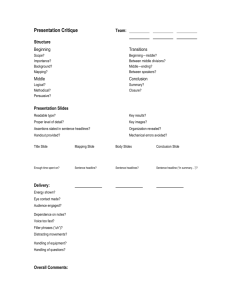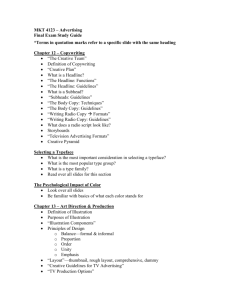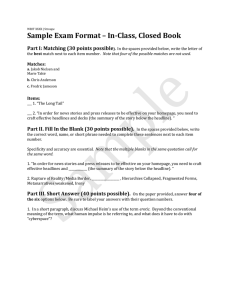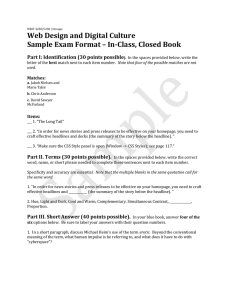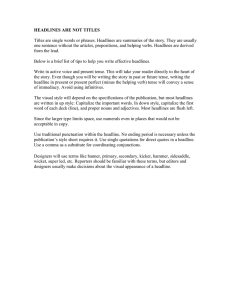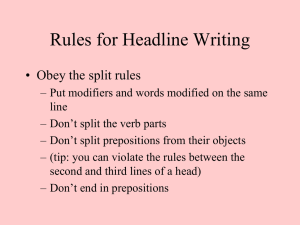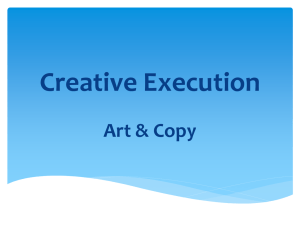Copywriting; Design and Production
advertisement
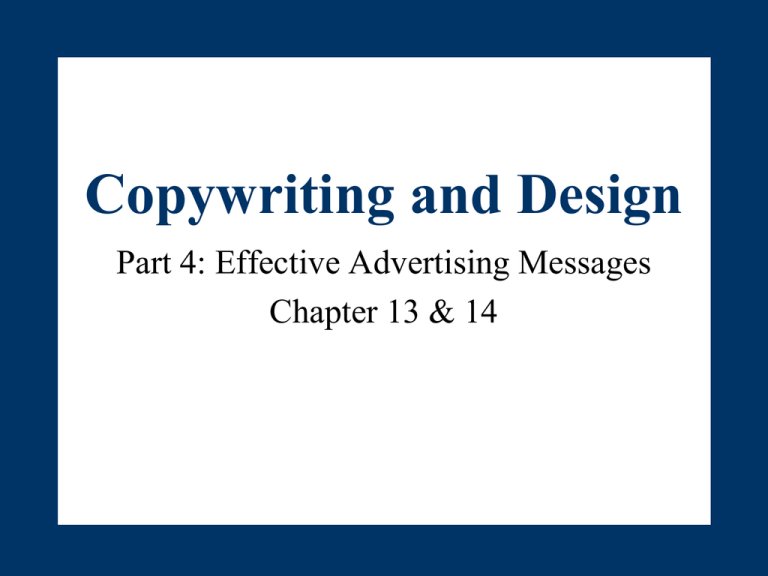
Copywriting and Design Part 4: Effective Advertising Messages Chapter 13 & 14 The Writer as an Advertiser • • • • "I have learned that it is far easier to write a speech about good advertising than it is to write a good ad." – Leo Burnett, quoted in 100 LEO's, Chicago, IL: Leo Burnett Company, p. 27. "If you are writing about baloney, don't try to make it Cornish hen, because that is the worst kind of baloney there is. Just make it darned good baloney." – Leo Burnett, quoted in 100 LEO's, Chicago, IL: Leo Burnett Company, p. 23. "I have discovered the most exciting, the most arduous literary form of all, the most difficult to master, the most pregnant in curious possibilities. I mean the advertisement . . . . It is far easier to write ten passably effective Sonnets, good enough to take in the not too inquiring critic, than one effective advertisement that will take in a few thousand of the uncritical buying public." – Aldous Huxley (1923), British author, quoted in Robert Andrews, The Columbia Dictionary of Quotations, 1993, New York, NY: Columbia University Press, p. 18. "The trouble with us in America isn't that the poetry of life has turned to prose, but that it has turned to advertising copy." – Louis Kronenberger (1954), quoted in Rhodas Thomas Tripp, The International Thesaurus of Quotations, 1970, New York, NY: Thomas Y. Crowell Company, p. 18. 13 - 2 Copywriting: The Language of Advertising • Four types of ads in which words are crucial 1. 2. 3. 4. • If the message is complicated If the ad is for a high-involvement product Information that needs definition and explanation If a message tries to convey abstract qualities Copywriter – The person who shapes and sculpts the words in an ad 13 - 3 This Norwegian ad is somewhat copy intensive, but uses copy for artistic purposes 13 - 4 Advertising Writing Style • Copy should be as simple as possible • Should have a clear focus and try to convey only one selling point • Every word counts; space and time are expensive • • • • • • • • • Practical Tips Be succinct Be single-minded Be specific Get personal Keep a single focus Be controversial Be original Use variety Use imaginative description 13 - 5 Copywriting for Print • Display copy – Elements readers see in their initial scanning • Body copy – Elements that are designed to be read and absorbed The Headline • Key element in print advertising • Conveys the main message • Works with the visual to get attention and communicate creative concept 13 - 6 How to Write Headlines • A good headline will attract those who are prospects • The headline must work in combination with the visual to stop and grab the reader’s attention • The headline must identify the product and brand, and start the sale • The headline should lead readers into the body copy – Direct-action headlines – Indirect-action headlines 13 - 7 Types of Headlines Headlines Can be Grouped Into Two General Categories Direct Action Indirect Action Assertion Puzzles Command How-to Statements Associations News Announcements 13 - 8 How to Write Other Display Copy • Captions – Have the second-highest readership and serve an information function • Subheads – Sectional headlines used to break up a large block of copy • Taglines – Short, catchy, memorable phrases used at the end of an ad to complete the creative idea • Slogans – Repeated from ad to ad as part of a campaign or long-term brand identity effort 13 - 9 How to Write Body Copy • Body copy – The text of the ad – Primary role is to maintain the interest of the reader • Lead paragraph – The first paragraph of the body copy – Where people test the message and see if they want to read it • Closing paragraph – Refers back to the creative concept and wraps up the Big Idea – Call to action 13 - 10 Print Media Requirements • All media in the print category all use the same copy elements • The way these elements are used varies with the objective for using the medium Newspapers • Copy does not have to work as hard to catch audience’s attention • Straightforward and informative • Writing is brief 13 - 11 Print Media Requirements Magazines • Better quality ad production • Ads can be more informative and carry longer copy Directories • Use a headline that focuses on the service or store’s personality • Little space for explanations 13 - 12 Print Media Requirements Posters and Outdoor • Primarily visual • Words try to catch the consumer’s attention and lock in ideas • An effective poster marries words with visuals Product Literature • Also called collateral • Used in support of an ad campaign • Typically a heavy copy format 13 - 13 Principles of Effective Print Advertising By Steve Blom Principles of Effective Print Advertising • • • • Establishing an Objective Sell to the Objective Designing the Ad Evaluate the Ad 13 - 15 Establishing the Objective • Main selling idea should be aimed at the objective; resist the temptation to add more • Support the main selling idea with all elements of the ad – Headlines – Visuals – Copy 13 - 16 Sell to the Objective • Sell the merits of the Product or Service – What’s in it for me? • Emphasize benefits, not facts – Fact: Birdie Drivers are made of solid unobtanium with a unique plasticized hydroid alloy core – Benefit: Birdie Drivers are lighter, faster, harder, and cheaper than our competitor Bogie Drivers, and they consistently hit longer, straighter shots 13 - 17 Designing the Ad • Design for Easy Reading – – – – – – KISS Solve a problem Call to action Don’t try to cram everything in Don’t overfancify your design Avoid: • • • • • Dark backgrounds Small headlines Difficult to read fonts Unrelated images Atypical layouts 13 - 18 Designing the Ad • Illustrate your product in use – Show what the product can do for the reader – Avoid static graphics showing whole lines of products • Avoid Humor and Shock value – You’re probably not as funny as you think you are – Humor or shock almost never works toward your objective 13 - 19 Evaluate the Ad • Repeat a Successful Ad; Drop an Unsuccessful One – Repetition is good, to a point – Good ads wear out a lot slower than you think – Because you are tired of it doesn’t mean your audience is • Don’t Blame Ad Placement for Poor Performance – Design has far more to do with the success than getting it on cover 4. L 13 - 20 Designing for Print • First responsibility of the art director is to choose visual elements used in ad or commercial to produce a layout. – Plan that imposes an orderly arrangement that is aesthetically pleasing. – Map, the art director’s blueprint. – Communication tool for others so that the idea can be discussed and revised. – Many ways to lay out an ad; different ways create different feelings about the product. 13 - 21 Layout (Handout) The General Steps in a Layout Are: Thumbnail Sketches Preliminary Sketches Rough Layouts Ads Done to Size Without Attention to Looks Semicomps Layout Drawn to Size, Used for Presentations Comprehensives Art is Finished, Designed to Impress Audience Mechanical L Largely Computer Based and Generated to Guide Color Separations 13 - 22 How to Write Radio Copy • Must be simple enough for consumers to grasp, but intriguing enough to prevent them from switching the station • Ability of the listener to remember facts is difficult • Theater of the mind – The story is visualized in the listener’s imagination 13 - 23 How to Write Radio Copy • Voice • Music • Sound effects • See radio script in handout packet • • • • • • Radio Guidelines Keep it personal Speak to listener’s interests Wake up the inattentive Make it memorable Include call to action Create image transfer 13 - 24 How to Write Television Copy • Moving action makes television so much more engaging than print • The challenge is to fuse the images with the words to present a creative concept and a story • Storytelling is one way copywriters can present action in a television commercial more powerfully than in other media 13 - 25 Tools of Television Copywriting • • • • • • Video Audio Voice-over Off camera Other TV Tools The copywriter must describe all of these in the TV script • • • • Talent Announcers Spokespersons Character types Celebrities 13 - 26 Scripts and Storyboards • Script – The written version of the commercial’s plan – Prepared by the copywriter – See handouts • Storyboard – The visual plan or layout of the commercial – Prepared by the art director – See handouts 13 - 27 Frontier Photoboard 13 - 28
